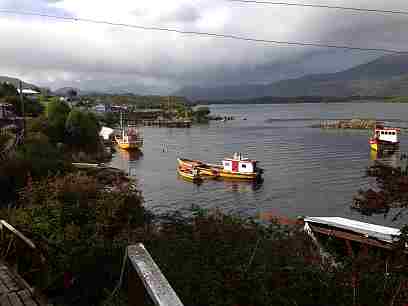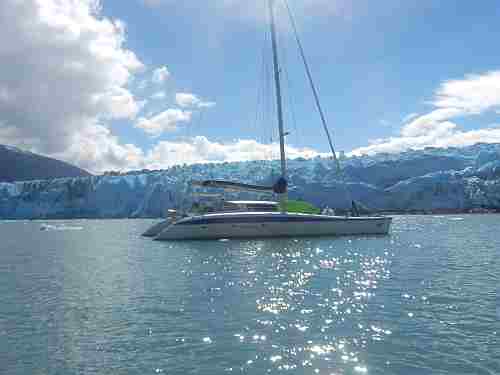47 16S 75 02W
4 April 2014
Dear friends,
I got up at dawn this morning. For 2 days, since Jan left the boat, I have traveled slowly - no more than 2 or 3 hours per day, and each day I have stopped and walked on the granite rocks at the steep sides of the fjords. There are no paths in this part of the world.
Pressure has been high and the sky has been mostly solid blue. 2 months in the southern channels with Jan have come & gone and Dulcinea will slowly head north to lay up for a few months while we enjoy summer in Canada.
However, today I am crossing the Golfo de Penas - a full day with 50 miles exposed to the open Pacific Ocean, and 80 miles total. The Gulf is known for for big seas and savage storms. Today, however, there has been no wind since 10.00am and the sky is blue from the white peaks of the Andes in the east to the crests of the ocean swell in the west. The mainsail is hanging limply from the mast (drying the laminate material) and one of the 2 engines is humming along steadily.
Several tiny petrels and 1 or 2 albatros visit. Some seals put up their heads to watch me. I called the lighthouse on Isla San Pedro to check in with the Chile Navy, but don't expect any other human contact for the week or more before arriving at Isla Chiloe. The weather has warmed since we last wrote.
Tomorrow will be bath day at the hot springs by Bahia Hoppner. Its nice to have your own transport and be able to stop as & where you waant.
We stopped twice last month at coastal villages of Puerto Eden, and Caleta Tortel. Tortel has a few hundred people and a road connection of 11 hours on dirt roads to Coyhaique, but Eden has only boat access and probably less than 100 people. Each town is made of wooden homes connected by boardwalks cut from the local trees. Otherwise, we have anchored on our own and tied to the banks in coves and tiny channels.
When we last wrote, we were just out of Puerto Natales, where the Port Captain told us the port was closed because of 50 knot winds. We knew Canal Union and Ensenada Sin Salida are famous for strong contrary winds and we got them, but I comitted to get Jan to Caleta Tortel before the end of March for her flight back to Canada, so Dulcinea powered up north against them.
The approach to Seno Peel & the Amalia Glacier was choked with floating ice, but instead we headed up the Seno Eyre to the toe of Pious XI Glacier with views up to the great Southern Icefield. We measured the front of the glacier with the radar and it is over 2 miles across.
A few iceburgs decorated the approach and schools of dolphins came to play. We discovered that these dolphins, which are a uniquely Chilean species and live in the brackish water, are large, strong and particularly playful. They spot us from a mile or two and come leaping over. From Dulcinea's bows they make a lovely & impressive sight. However, they show the same joi de vive greeting the dinghy powering at twice our speed and giving the odd nudge which is quite alarming when you are in a light inflatable RIB on the plane while trying to get ashore or pull mooring lines across to trees.
We also ventured up Seno Iceberg, for another trip to the toe of a tidewater glacier. Here we were surprised to find a park warden's house. The occupants told us they had just walked in 30 km. but we looked at the map and they must have had a long boat ride to get within 30km.
As we moved north, the trees became rapidly bigger. Twice, we saw otters at the steep sides of the fjords as we traveled. On 19 March, an unexpected N wind built to 40 knotes so we tucked into Caleta Grau where we found a family of seals playing in the sheltered water under the trees. We tied 4 lines to the banks, and went ashore to burn our accumulated garbage, then spotted a baby otter which was poking his nose out of the bushes to watch us.
Well, its less than 15 miles now to the north shore of Golfo de Penas, so it's time for a cup of tea to help my mental preparation for coming back to land.
Best wishes from Dave & Dulcinea

